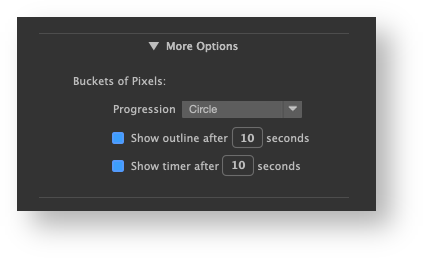The 3Delight Preferences dialog located in the sidebar of 3Delight Display.
3Delight Preferences lets you choose the compute resources you want to use for rendering: either your computer, a 3Delight Collective or 3Delight Cloud. They apply to any rendering launch from your account (from any DCC like Maya, Houdini, etc.). They do not apply to the command line 'renderdl' (which has its own set of command line options to select these resources).
This Computer
This is the common option to render using your own computer. With this option, you have three speed levels to choose from: Full Capacity, 90% Capacity, Half Capacity. Typically, you select Full Capacity to render as fast as possible. If you would like to leave some processing capacity for other tasks (eg. for a more responsive UI), you can choose 90%. To leave even more capacity for other tasks, select Half Capacity.
The number of cores used for rendering as a result of your speed selection will be displayed. If you see the following notice underneath it it means you are using the Free 3Delight and the number of cores has been restricted:
You can subscribe to a 3Delight Membership to unlock the full capacity of your computer.
3Delight Collective
Select this option if you would like to render using several computers or servers from your network. For this option to be available, you must have pre-defined one or more collectives as explained in 3Delight Collective. Note that you can use both This Computer and 3Delight Collective at the same time to supplement your computer to the collective.
The total number of cores available from the collective will be displayed. You must have enough 3Delight licenses available for this option to work fully (i.e. as many licenses as the number of computers in the selected collective).
3Delight Cloud
Select this option if you would like to render using 3Delight Cloud. With this option, you have four speed levels to choose from, each level aiming to increase the number of cores by a factor of 3 from the previous one. Since the actual number of cores used by 3Delight Cloud is proportional to the resolution of your image, and is also affected by the available cloud resources, here is how many cores are typically used for HD and 4K renders at the four speed levels:
Speed | HD | 4K |
|---|---|---|
| Econo | 56 cores | 224 cores |
| Normal | 168 cores | 672 cores |
| Fast (16 BPC) | 506 cores | 2025 cores |
| Ludicrous | 1518 cores | 6072 cores |
The actual number of cores likely to be used as a result of your selection will be displayed. If you see the following notice underneath it it means that number has been capped by the maximum Spending Rate Limit for your account (which you can modify):
The speed level selection only applies to preview renders (i.e. single image rendering outputted to the display). The rendering of a sequence is always done at econo speed. This is because these is no need to rush a single image and instead several images can be rendered simultaneously and more efficiently.
The speed level selection only applies to preview renders (i.e. single image rendering outputted to the display). The rendering of a sequence is always done at econo speed. This is because these is no need to rush a single image and instead several images can be rendered simultaneously and more efficiently.
More Options
Typically, an image is rendered gradually in small groups of pixels called buckets. The following options allows you to control how the progress occurs and whether progress indicators are displayed or not.
Progression
Specifies in what order the buckets are rendered. It applies to both normal and live (IPRs) renders. The options are:
Progression | Description |
|---|---|
| Horizontal | Buckets are rendered row by row, from left to right and from top to bottom. |
| Vertical | Buckets are rendered column by column, from top to bottom, and from left to right. |
| Zigzag | Buckets are rendered row by row, from left to right on even rows, and from right to left on odd rows. |
| Spiral | Buckets are rendered in a clockwise spiral starting at the centre of the image. |
| Circle | Buckets are rendered in concentric circles starting at the centre of the image. This is the default option. |
Show outlines after [ n ] seconds
Shows an outline around the bucket (or group of buckets) being processed. This outline will be shown only if the processing time exceed the "n" seconds you specified. Typically, for buckets that are calculated rapidly, showing such outline is not useful.
Show timer after [ m ] seconds
For buckets that are even longer to process, you can have a timer (in second) displayed over them while their processing continue. The timer will only be displayed after the processing time exceed the "m" seconds you specified.



